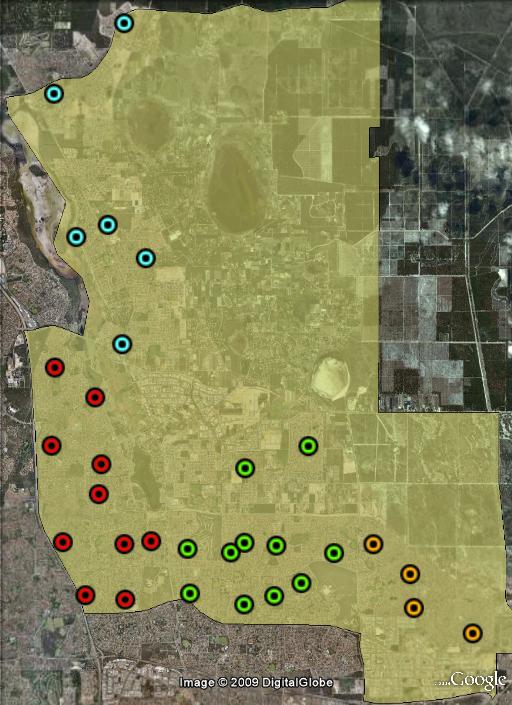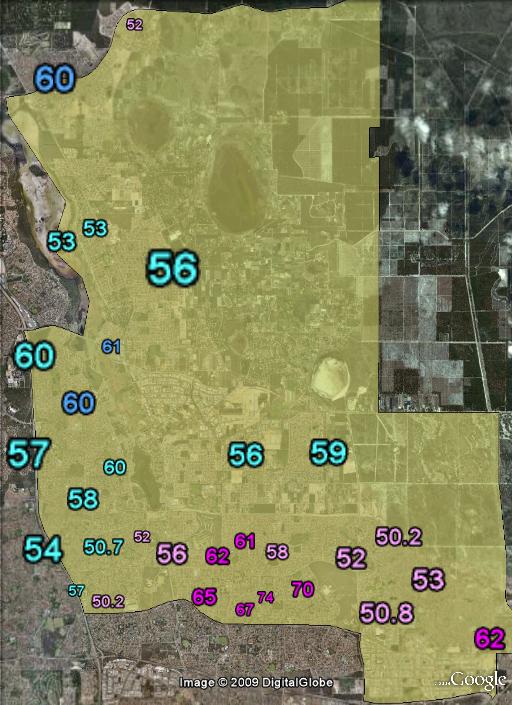LIB 1.3%
Incumbent MP
Luke Simpkins, since 2007.
Geography
Cowan covers parts of the northern suburbs of Perth. These include the suburbs of Ballajura, Marangaroo, Girrawheen, Greenwood, Kingsley, Woodvale, Wanneroo and Banksia Grove.
Redistribution
Cowan lost territory to the north of Joondalup Drive to Moore. It also lost the territory south of the Reid Highway, specifically the suburb of Noranda. The margin was reduced from 1.7% to 1.3%.
History
The seat was first created in 1984, and was first won by Carolyn Jakobsen of the ALP. Jakobsen held the seat until she was defeated by Richard Evans of the Liberal Party in 1993.
Evans was himself defeated in 1998 by wheelchair-bound Vietnam veteran and former state minister Graham Edwards, standing for the ALP. Edwards was a popular local member and held the seat until he retired at the 2007 election. The Liberals took the opportunity to win the seat off the ALP. Cowan was one of only two seats the Liberals gained in 2007.
Candidates
- Rob Phillips (Greens)
- Chas Hopkins (Labor)
- David Kingston (Christian Democratic Party)
- Luke Simpkins (Liberal) – Member for Cowan since 2007.
- Alan Leach (Family First)
Political situation
The Liberals have only won Cowan three times in the last 25 years, and the ALP will have a good chance to gain the seat, particularly if the ALP gains ground in Western Australia. On the other hand, the ALP have lost their hand-picked candidate and are in trouble in the local area.
2007 result
| Candidate | Party | Votes | % | Swing |
| Luke Simpkins | LIB | 38,872 | 45.81 | +1.42 |
| Liz Prime | ALP | 35,633 | 41.99 | -1.88 |
| Johannes Hermann | GRN | 4,778 | 5.63 | +0.04 |
| Martin Firth | CDP | 1,584 | 1.87 | -0.58 |
| Rhonda Hamersley | FF | 1,452 | 1.71 | +1.71 |
| Ken Lee | LDP | 1,003 | 1.18 | +1.18 |
| Dave Tierney | ON | 783 | 0.92 | -1.09 |
| Norm Ramsay | IND | 558 | 0.66 | +0.66 |
| Roger Blakeway | CEC | 195 | 0.23 | -0.14 |
2007 two-candidate-preferred result
| Candidate | Party | Votes | % | Swing |
| Luke Simpkins | LIB | 43,883 | 51.71 | +2.49 |
| Liz Prime | ALP | 40,975 | 48.29 | -2.49 |
Results do not take into consideration effects of the redistribution.
Booth breakdown
I have divided Cowan into four areas based on local government areas. The south-western part of the seat lies in Joondalup LGA, while the south-eastern part of the seat lies in Swan LGA. A majority of the population lives in Wanneroo LGA. Those booths in the south of Wanneroo have been classified as ‘central’ while booths in the north of the seat have been separately classified.

| Voter group | GRN % | LIB 2CP % | Total votes | % of ordinary votes |
| South-West | 6.63 | 56.60 | 21,421 | 32.53 |
| Central | 4.80 | 44.10 | 20,837 | 31.65 |
| North | 4.81 | 56.28 | 14,014 | 21.28 |
| South-East | 4.95 | 45.98 | 9,568 | 14.53 |
| Other votes | 6.98 | 53.67 | 14,148 |



The 2004 Senate vote in Cowan indicates that it was held on Edwards’ personal vote alone. Voters love soldiers perhaps.
Candidate update: Former Lord Mayor of Perth Chas Hopkins has nominated for ALP preselection.
The ALP are extending the deadline for nominations, again:
http://au.news.yahoo.com/thewest/a/-/breaking/6795792/labor-struggling-to-find-cowan-candidate/
Chas Hopkins has finally been selected as the Labor candidate.
This is almost three separate seats in one. It takes in the state seat of Kingsley in the southwest (solid Liberal), Girrawheen and part of Nollamara in the southeast (both solid Labor), and the rapidly changing area of Wanneroo to the north. In my view the latter has sealed the deal and Labor are not as assured here as they once were.
The southwest of the electorate could well be a northern extension of Stirling – it was built in the 70s and early 80s, it’s established, the empty nester vote is strong here, etc. The Beach Road dividing line is really very artificial. There are slight demographic differences – eastern Greenwood and Warwick are significantly lower on the social ladder than the rest of the area, so those areas tend more Labor than western Greenwood, Woodvale and Kingsley which are as good as assured. Incidentally, a party man once told me that back when there were three booths in Greenwood, people looked at the middle one as an early indication of the overall Perth-wide health of Labor on election night.
The southeast is among the lowest socioeconomic areas in Perth, and is very, very ethnically diverse with among other things an African church, a Buddhist temple and a Vietnamese Catholic church in the suburb of Girrawheen and there’s Asian supermarkets everywhere. North of Marangaroo Drive it is lower middle class rather than welfare class. This area weakening a little (eg 70% to 60% Labor) in 2004 was what knocked the seat into marginal territory, but it actually recovered a little in 2007.
The death blow was delivered by Wanneroo – and not for the last time, as Labor MP Diane Guise was to find out at the next State election. Brand new, with estates springing up everywhere, this is apparently according to the ABS the fastest growing part of Australia. And the demographic moving in is for the most part at the top of the scale. What used to be the quiet country town of Wanneroo is now completely encircled by lifestyle estates with people who are in the top 4% of the population by economic advantage, while slightly less affluent have moved into the former market gardens of Madeley, Darch and Landsdale. Many of these people are from England, South Africa or from the eastern states. The old part of Wanneroo probably still leans Labor as it always did, but it’s been so overwhelmed by the newcomers that I think it’s probably a fairly certain Liberal area now. The only exception is the Homeswest estate area up at Banksia Grove (the tiny pink 52 in your map).
So, in my opinion, while Girrawheen’s Labor vote will recover a little more and Greenwood will, as it always has, follow whatever swing occurs metro-wide, the unbelievable demographic change in Wanneroo means the seat will stay in Liberal hands for now. Demographic change, though, can be an unpredictable beast so who knows what will happen in 2013 or 2016.
Good summary of Cowan Adam, I happen to live in this seat and this coming election is the first I will be casting my vote in.
My prediction: Liberal retain, 2% swing to them.